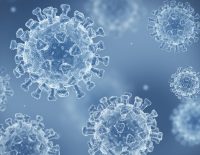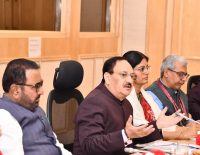Gynecological Cancer : Prevention and Screening
By Abhishek Shankar, Pritanjali Singh

Globally, cancer has emerged as an important contributor to human health and burden is growing with each passing year. Cancer has emerged as an important health issue in last few decades. Cancer has multifactorial causation theory and presents with different signs and symptoms as per the organ of origin. In India, 1.4 million people are diagnosed with cancer annually and 8, 50,000 cancer patients die of it every year. Carcinoma of breast, lung, mouth, cervix,stomach and head & neck are major cancer types which are preventable but majority of cases are diagnosed at advanced stages.
Screening plays a significant role in detecting cancers at early stage before appearance of the symptoms. This may involve blood tests, urine tests, genetic tests, medical imaging or other tests.In the situation, where most of the cancer cases in low and middle income countries (LMICs) are presenting to hospitals at advanced stage, cancer prevention and screening will be a cost effective exercise to reduce cancer incidence and related mortality by detection of precancerous lesion and invasive cancer at early stages. There are many controversies related to the age of screening, methods of screening, benefits and harms of cancer screening, cost effectiveness with surrounding debates of its usefulness as a lifesaving procedure.
Gynecological cancers are among the most common cancers in women and hence an important health issue. Due to the lack of cancer awareness, variable pathology, and dearth of proper screening facilities in developing countries such as India, most women report at advanced stages, adversely affecting the prognosis and clinical outcomes. This is an important agenda to focus more on cancer prevention and screening to make sure that cancer patients should reach early to the hospital.
Health Promotion Approaches for Cancer Prevention
Health promotion interventions can help to decrease the incidence, prevalence of Non-communicable Diseases (NCDs) including cancer.Health promotion activities as a preventive measure for cancer are focused on underlying risk factors like physical inactivity, overweight and obesity, dietary factors including fruit and vegetable intake, tobacco and alcohol use, infections, and environmental and occupational exposure.
Physical inactivity attributes to nearly 5% of all cancer deaths. Many studies have reported that physical activity decreases the development ofendometrial cancer andfew studies. In a systemic review by Voskuil et al (2009) found that vigorous physical activity is strong associated with reduced risk of endometrial cancer in comparison to females with no physical activity.
In a population based case control study in Canada, positive association between obesity and cancer risk was found. Obesity was a risk factor for cancer ovary (OR = 1.95). In United Kingdom,a cohort study was conducted on 5.24 million individuals to investigate link between BMI and cancer risk. Increased risk of carcinoma of uterus (HR = 1•62), cervix (HR = 1•10) was estimated with increase of each 5 unit above BMI 22.It is also estimated that 41% of uterine carcinoma due to obesity and overweight and there will be an increase in cancer incidence by nearly 3800 cases with every 1 unit increase in BMI.
Evidence suggests that gynecological cancers are caused by various tobacco products. Counseling for tobacco cessation and behavioral therapy are also required for persons willing to quit tobacco. Some of the methods like “5 A” i.e. Ask, Advise, Assess, Assist and Arrange or “5 R” i.e. Relevance, Risk, Reward, Roadblock of tobacco use and quitting and Repeat this process at every visit. Motivation and/or fear is utmost requirement for a person to quit tobacco.
Human Papilloma viruses (HPV) infection is associated with cancer of cervix, vagina, vulva, head and neck cancer, and anal canal in females. In case of cervical cancer, nearly 90% cases have presence of HPV and the two most commonly found strains are HPV 16 and 18.
Human Papillomavirus (HPV) vaccine
HPV vaccine prevents the infection and reduces the risk of cervical and other cancer types caused by HPV. Cervarix by GlaxoSmithKline Biologicals and Gardasil by Merck & Co., Inc. are currently available HPV vaccines. Cervarix is a bivalent vaccine containing protection against HPV type 16 & 18, two most high risk strains responsible of 90% of cervical cancer. Gardasil is available in quadrivalent and nonavalent containing HPV strain 6, 11, 16 & 28 (and additionally 31, 33, 45, 52, and 58 in nine-valent as Gardasil 9). Efficacy of the vaccine is reported between 95% – 100% for HPV 16 & 18. Also, studies have confirmed the cross protection by HPV 31, 33 and 45. Millions of population have already vaccinated and vaccine have been reported to be effective in reducing the risk of genital warts, precancerous lesions and invasive cervical cancer.
Recommended age group for HPV vaccine is 9 – 26 years, but before the initiation of active sexual life. As per updated evidence from Indian follow-up cohort study, two-dose recommendation for Human Papillomavirus vaccine can be followed for children aged 9 – 14 years with regimen 0, 6 months. All other individuals aged 19 – 26 years along with immunocompromised person should follow three dose regimens.
Chemoprevention of Cancer
Using a therapeutic agent to delay or inhibit the progression of disease is known as chemoprevention and there are many substances, medicines, compounds and agents which are used for chemoprevention in cancer. In recent years, advancement and improvement of research has given more insight about cancer biology. Many of the therapeutic agents for chemoprevention, currently under trails, are debatable.
HPV vaccines are proven to be clinical beneficial to lower the burden of cervical carcinoma. Diet rich in vitamin C reduces the risk of cervical cancer. Other trials were conducted using supplements like beta carotene and folic acid but none of them were found to be clinically beneficial.
Evidence-Based Cancer Prevention & Screening
Prevention and screening of cancer focus on reducing the cancer incidence and mortality. It is an important step to make general population more aware about sign and symptoms of different cancers. Prevention of cancer include change in lifestyle and eating habits, behaviour change and reduction in environmental and occupational carcinogen exposure, while screening aims at detecting the pre-malignant lesions or cancer at early stage where chances of cure are much higher.
Signs & Symptoms
Cervical Cancer Vaginal bleeding between periods or after menopause
Vaginal discharge
Pain in pelvic area and back
Development of carcinoma takes many years and remains in latent state until affecting any organ or system. Even exposure to known carcinogens,like tobacco smoke and HPV, take many years to develop into cancer after appearance of pre-malignant lesion. Pre-malignant lesion can be detected through regular screening and early interventions can reduce the risk of cancer. Also, chances of cure and survival increase multi-fold if cancer is detected in early stage. Decade of research has established the effective screening methods for many cancers, leading to better survival outcome.
In India, cancer burden is high and there is high cost of cancer treatment, less expenditure on public healthcare, high out of pocket health expenditure despite many government health schemes. To prevent the burden of rising number of NCDs government of India launched National Programme for Prevention and Control of Cancer, Diabetes, Cardiovascular Diseases and Stroke (NPCDCS), under which screening of breast, cervical and oral cancer is done at community level. These three cancers contribute a major burden of cancer in India and are easily preventable and treatable if detected early, can help to reduce mortality.
As per USPSTF recommendations, women aged 21 – 29 years should be screened with cervical cytology examination (pap smear or test) every three year. Women aged 30 – 65 years, cervical cytology examination every three year and HPV DNA test every five year or contesting with Pap test and HPV DNA test every 5 year is recommended. No screening is recommended for women below 21 years. American Cancer Society, American Society for Colposcopy and Cervical Pathology, and American Society for Clinical Pathology recommended cervical cancer screening in the same line as USPSTF.
Operational framework for management of common cancers in India recommends Visual Inspection with Acetic Acid (VIA) for women aged 30-65 years, every 5 years for cervical cancer screening. Women with aceto-white regions in cervix after VIA are further investigated by cryotherapy or biopsy.
Oncologists have limited their role in diagnosis and treatment of cancer, but there is a need to extend the role of oncologists’ in cancer prevention and screening. Oncologist can play a crucial role in cancer prevention and control by risk assessment of high risk group people. Caregivers and family members are keen to know about cancer and their risk of developing cancer after diagnosis of cancer to their loved ones.Oncologists are expert in tracing the natural history of cancer, carcinogens and its effects on human body with preventive measure for various cancers. Oncologist can play a role not only in disseminate information and awareness, but also identifying the barriers in prevention of cancer.
A multipronged strategy is needed to tackle the growing burden of cancer and striking the preventable cancer burden could be the best long term approach. Lack of nationwide screening guidelines and vaccination strategies are further hurdles in inciting an attack on these preventable cancers. Apart from government initiatives, advocacy by civil society and efforts of non-government organizations also needs to be promoted in this regard. In summary, the unique challenges of preventable cancer burden may be dealt with indigenous and country-specific approaches which may result in a sustainable long term control of cancer.
AUTHORS: Dr Abhishek Shankar is Associate Professor in Department of Radiation Oncology at All India Institute of Medical Sciences, Patna; Associate Editor, APJCP; Editor in Chief, APJCC; Associate Editor, SAJC, and Founder Secretary of Indian Society of Clinical Oncology. He tweets with @ShankarAbhishek. Dr Pritanjali Singh is Additional Professor& Head of Department of Radiation Oncology at All India Institute of Medical Sciences, Patna. Views expressed are personal.








Comments